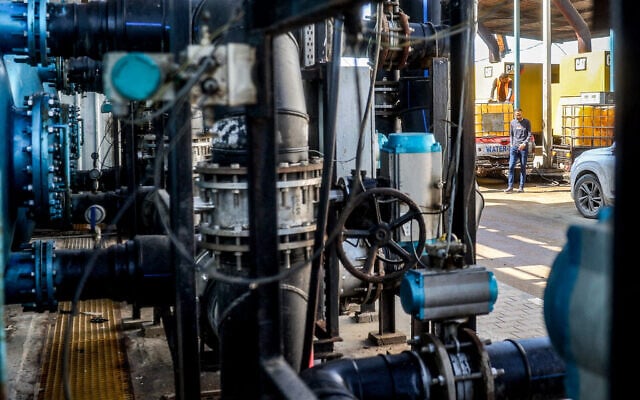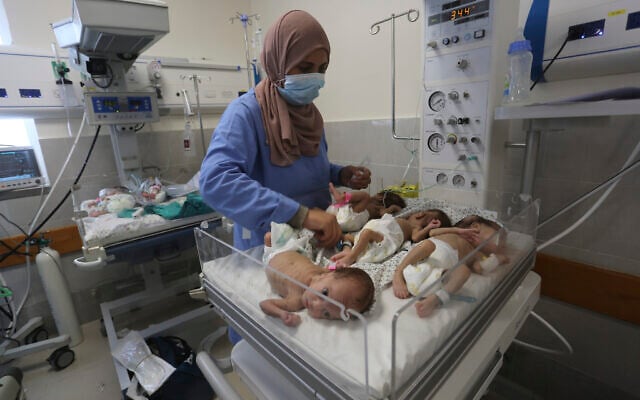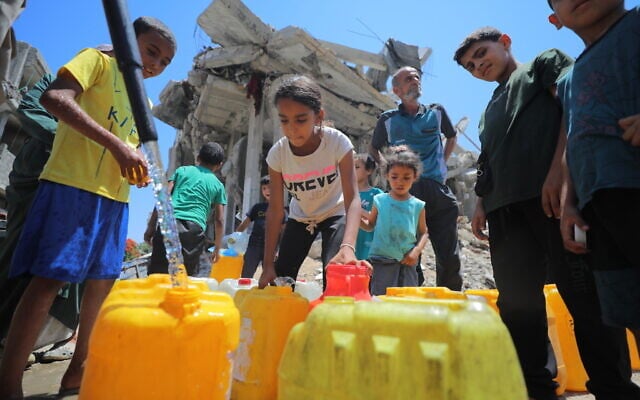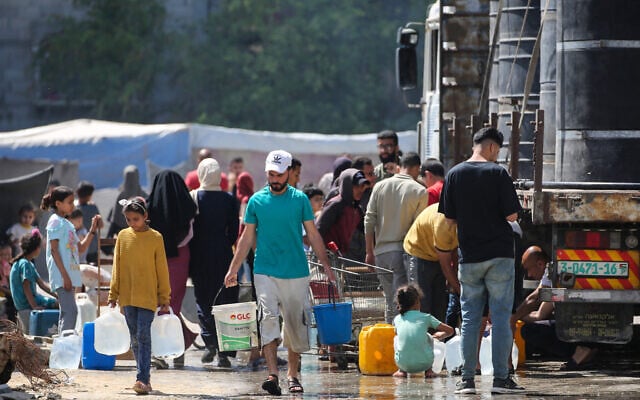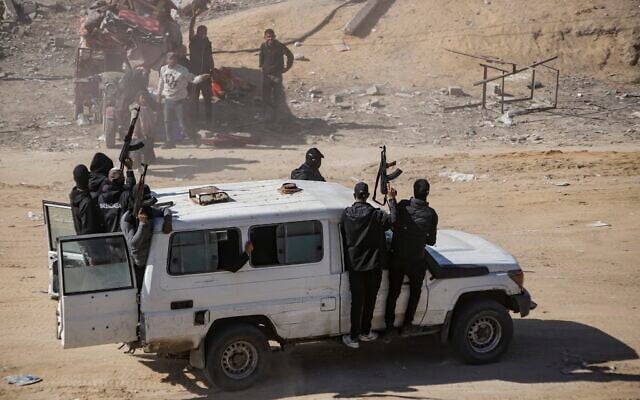


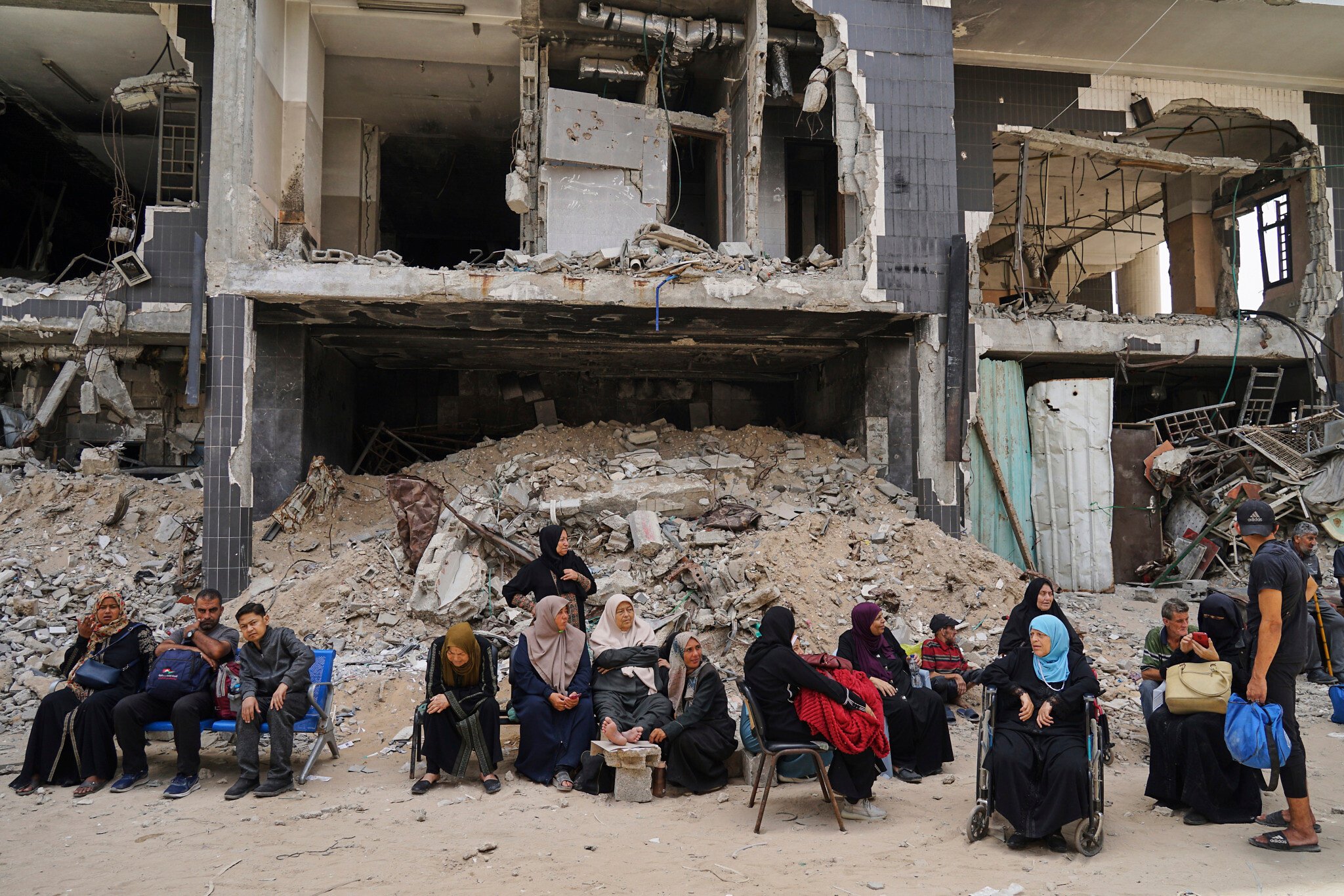
Fuel — specifically diesel fuel — is currently Gaza’s only source of energy. It powers generators that run essential systems, including medical equipment and water desalination plants that provide drinking water to Gaza’s 2 million residents.
For much of the war, the desalination plants in central Gaza’s Deir al-Balah, were powered by the single transmission line linking the enclave to Israel’s electric grid. But on March 3, a day after Israel stopped allowing humanitarian supplies into Gaza, including fuel, Energy Minister Eli Cohen cut the electric line.
Today, assistance is once again entering Gaza, but not fuel, and the power line remains dormant. Powering Gaza’s various needs uses hundreds of thousands of liters of fuel daily, and supplies are quickly running out, Palestinians in the enclave say.
“Hospital generators run for one hour and then stop for an hour due to the fuel shortage,” a doctor at Gaza City’s Shifa Hospital told The Times of Israel by phone recently. “Electricity in hospitals is not consistent — sometimes it’s available for only three to four hours a day.”
Fuel shortages have plagued Gaza throughout the war, he said, but in recent months the situation has worsened significantly.
Gaza has now been without fuel coming in for longer than at any point during not only the war, but since Israel began implementing limitations on the entry of equipment and supplies into the Strip following Hamas’s 2007 takeover.
At the start of the war, Israel kept fuel out for 40 days before a cacophony of international pressure got the proverbial spigot turned back on. The current freeze has lasted three times as long and counting.
Israeli authorities have not publicly addressed the continued restriction on fuel or why it remains cut off even as other forms of humanitarian aid have been allowed in.
The Coordinator of Government Activities in the Territories (COGAT), a Defense Ministry unit tasked with logistical coordination between Israel and the Gaza Strip, did not respond to Times of Israel requests for comment on why the fuel ban persists.
Dozens of hospitals across Gaza are facing imminent closure as a result of the fuel shortage, which has crippled critical infrastructure, according to the World Health Organization.
Services are already being drastically reduced.
“The energy situation and the condition of hospitals have been dire since the beginning of the war, but every day it gets worse,” the doctor at Shifa Hospital said. “In some hospitals, surgeries and medical treatments cannot be completed due to shortages of medical supplies, water, food, and electricity. This has a major impact on patient health and recovery.”
He added that, due to the deteriorating conditions, hospitals are increasingly discharging patients earlier than medical providers may prefer.
Dr. Rik Peeperkorn, a WHO representative currently in Gaza, said in a video statement published on July 1 that the hemodialysis center at Shifa Hospital had been forced to reduce its treatment hours due to the fuel shortage.
“Normally, patients receive three dialysis sessions a week, four hours each. Now, the hospital has had to reduce both the number of sessions and the duration of each one because of the fuel crisis,” he said. “The fuel shortage is also impacting the intensive care unit and every other department in the hospital.”
In June, the UN Office for the Coordination of Humanitarian Affairs published a report quoting the unnamed head of a Doctors Without Borders medical team in Gaza City saying the shortage was endangering infants.
“Newborns in neonatal intensive care units are often too small to breathe on their own – they need ventilators and oxygen to survive,” the medical team leader said. “But recently, the fuel shortage at Al-Helou Maternity Hospital in northern Gaza has led to multiple power outages that shut down ventilators and oxygen supply, putting babies’ lives at immediate risk.”
The ongoing fuel crisis in Gaza is now severely impacting access to clean water, as key desalination plants and sanitation facilities rely on diesel-powered generators to function. One of the most critical facilities affected is the main desalination plant in Deir al-Balah in central Gaza, which has been forced to reduce operations due to being disconnected from Israel’s electricity grid and now due to the lack of fuel for diesel-powered generators.
Access to water in Gaza was already limited and precarious long before the October 7 Hamas attack and the subsequent war. The Strip relied on three main water sources: piped water purchased from Israel’s Mekorot company, three seawater desalination plants that require electricity to operate, and primarily, groundwater from several hundred wells in the coastal aquifer. However, seawater intrusion and pollution have made most of the well water unsafe to drink without treatment.
The war has further damaged Gaza’s water system. Many wells were destroyed during Israeli airstrikes. On November 9, 2023, Israel officially halted its water supply to Gaza, though partial deliveries resumed in the following months.
Despite Israeli coordination to repair damaged pipelines in 2024, the ongoing fighting and the mass displacement of residents make it unclear whether most of Gaza’s population currently has access to functioning water infrastructure. Israel’s military liaison unit, COGAT, did not respond to The Times of Israel’s request for comment on the issue.
Even before the war, Gaza’s fragile infrastructure meant many residents could not rely on water from their taps and instead purchased purified water from private vendors, storing it in household containers.
It is unclear where private companies selling water in Gaza are sourcing it from. It is possible they are accessing wells and purifying the water independently. It is not known whether these companies have any connection to Hamas.
OCHA reported on June 24 that the desalination facilities are operating at only 50% of their capacity compared to their output during the second ceasefire six months ago.
A UN-affiliated humanitarian survey conducted in June found a sharp rise in the number of Gazans reporting deteriorating access to water and sanitation. According to the survey, 97 percent of respondents said their access to drinking water had worsened in recent weeks, and 87% reported worsening sanitation conditions – up from 20% and 40%, respectively, in April. In addition, the percentage of households purchasing drinking water rose from 63% in April to 75% in June, reflecting growing dependence on private water vendors amid widespread supply shortages.
The diesel shortage is also crippling sewage and wastewater treatment services, which require electricity to function. On June 17, the Khan Younis municipality announced it had halted water services, sewage treatment, and wastewater operations due to a lack of fuel.
At the start of the war, Israel justified its refusal to allow fuel into the Strip by pointing out that it was being used by Hamas to power rocket launches, vehicles, and generators pumping air and providing light in the Strip’s extensive underground network, used by militants – and therefore would not be allowed into Gaza.
“Hamas is feeling the blow from the IDF and will continue to feel it,” IDF spokesman Daniel Hagari said on October 26, 2023. “Part of their functioning relies on fuel.”
In early November, the IDF backed up its claims with recordings suggesting that Hamas was diverting fuel intended for hospitals.
Israel approved the resumption of fuel deliveries to Gaza on November 18 of that year, just days before agreeing to a week-long ceasefire and hostage release deal with Hamas. Hamas had demanded fuel shipments as part of its agreement to release women and children it had kidnapped weeks earlier. Fuel continued entering Gaza after the deal expired, though Israel never publicly explained the decision.
It’s unclear whether Hamas still has access to fuel stockpiles inside Gaza or is able to use them. There have been recent reports of fuel theft, although it is not clear if Hamas or other armed actors, such as local clans, are responsible.
On June 9, OCHA reported that 260,000 liters of fuel were stolen from a storage site in northern Gaza. The theft occurred after multiple requests by the UN to coordinate access with Israel were denied, according to the UN.
COGAT did not respond to The Times of Israel’s request for comment.
Much of the fuel that is in the Strip is located in areas under IDF control. Israel has not officially disclosed how much territory is currently under its control, but according to Ynet, the IDF told Israel’s cabinet that it expects to complete its takeover of approximately 75% of the Strip within weeks.
According to OCHA, 82.6% of Gaza’s land area now lies within IDF-controlled zones or areas subject to displacement orders since March 18.
Humanitarian agencies seeking to retrieve fuel from storage sites in these areas must coordinate with the IDF to conduct a “fuel extraction” and transfer it to populated zones. The UN has reported significant challenges with this coordination.
In a June 26 update, OCHA stated that “on June 18, the UN managed to extract about 280,000 liters of fuel from stranded reserves in a restricted-access area of Rafah, after 12 previous requests were denied by Israeli authorities.”
Of five fuel extraction attempts made in Rafah later that month, three were successful and two failed due to unspecified “field constraints.”
COGAT did not respond to The Times of Israel’s request for comment.

